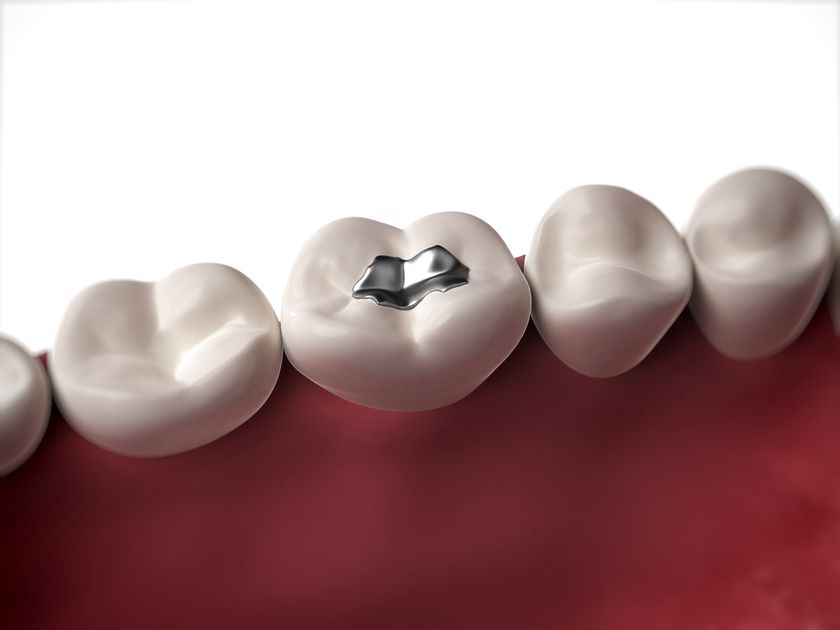- Categories :
- More
Signs Your Silver Fillings Need Replacement: The Woodlands Guide

Silver fillings, also known as dental amalgam, are a durable mix of metals used for decades to restore decayed teeth. Commonly placed in the 1980s to 1990s, these fillings are made from a blend of silver, tin, copper, and mercury. While they were once the standard choice for cavity treatment, many residents in The Woodlands are now opting to replace them due to visible wear, concerns about mercury content, and cosmetic preferences.
If you’ve had silver fillings for more than a decade, it may be time to assess their condition. Over time, they can crack, leak, or become loose, leading to further dental issues if left untreated. In this guide, our team at Nikita Vakil, DMD, explains how to recognize signs that your silver fillings may be failing, what to expect when replacing them, and why more patients are choosing modern alternatives. Whether your concerns are health-related or cosmetic, this blog will help you make an informed decision about your dental care.
Warning Signs Your Silver Fillings May Be Failing
Silver filling failure occurs when your dental restoration shows physical or visual deterioration. Our dentist in The Woodlands often sees patients with old amalgam fillings that have become damaged or ineffective over time. Knowing the early warning signs can help you prevent further complications.
How do I know if my silver filling is failing?
Several symptoms may signal that your silver filling is starting to break down:
- You feel pain when chewing on the tooth.
- You experience sensitivity to hot or cold drinks or foods.
- You notice dark stains or discoloration around the edge of the filling.
- You feel the filling move or become loose when touching it with your tongue.
These issues usually develop as the filling shrinks, cracks, or separates from the tooth structure, allowing bacteria to enter and cause damage beneath the surface.
What does a cracked silver filling look like?
Visual cracks can appear in aging fillings and should never be ignored. Here’s what to watch for:
- Gray lines or dark edges running along the surface of the filling.
- Jagged or uneven areas, especially visible under good lighting.
- Chips or pieces of filling that appear worn or fractured.
Cracks can compromise the seal between the filling and the tooth, letting bacteria in and increasing your risk of decay or infection.
What happens when a silver filling leaks?
Leaking fillings can lead to subtle but harmful changes in your mouth. You might notice:
- A bad taste that doesn’t go away
- New or increasing sensitivity around the tooth
- Darkening of the surrounding tooth structure
- Gaps between the tooth and the filling surface
Leakage allows bacteria and saliva to seep under the filling, often causing decay beneath the restoration that isn’t visible until it becomes severe.
What does it mean when a silver filling falls out?
If your filling has come loose or fallen out entirely, immediate dental attention is necessary. Here’s why:
- The exposed area can become sensitive or painful
- Bacteria can invade the unprotected cavity and trigger infection
- The tooth may fracture or break down further without protection
Our dentist uses clear dental reasoning, explaining that many physical failures of silver fillings result from years of chewing pressure, temperature changes, or enamel breakdown. If any of these warning signs appear, it’s wise to seek a Woodlands dental evaluation as soon as possible.
Age Factors That Affect Longevity
Silver fillings generally have a long lifespan, but like any dental material, they don’t last forever. At our Woodlands dental office, we often evaluate silver fillings that have been in place for 15 years or more. Over time, they can weaken or wear down due to everyday use.
How long do silver dental fillings last?
Most silver (amalgam) fillings last between 10 to 15 years. However, some may remain intact even longer with excellent oral hygiene and minimal chewing pressure on the treated tooth. That said, longevity varies based on several factors:
- Teeth grinding (bruxism): Repeated pressure can fracture or dislodge the filling
- Cavity recurrence: Decay can form around or underneath older fillings
- Acidic diet or poor oral care: These can erode the margins of the restoration
- Large filling size: Larger restorations tend to wear down or break more easily over time
Even if your silver fillings seem fine on the surface, hidden cracks or underlying damage can go unnoticed. That’s why regular dental checkups are essential to assess their condition and determine if replacement is needed.
Health Considerations for Older Silver Fillings
Concerns about the safety of silver (amalgam) fillings often lead patients to consider replacement, especially when the restorations are over a decade old. In The Woodlands, our dental office receives frequent questions about mercury exposure and whether old filling problems can affect overall health. It’s important to separate myths from facts and understand when replacement is medically appropriate.
Are silver dental fillings dangerous?
When intact, silver fillings are considered safe by major health organizations. The American Dental Association (ADA) and the U.S. Food and Drug Administration (FDA) state that amalgam is stable and effective. However, damage or deterioration may increase exposure to mercury vapor, particularly during chewing or teeth grinding.
For patients with concerns, our team offers trusted family dentistry services with composite materials that eliminate the need for metal restorations entirely.
Do silver dental fillings contain mercury, and should you be concerned?
Yes, traditional amalgam is made of about 50% elemental mercury, mixed with other metals to form a durable compound. Over time, chewing can release small amounts of mercury vapor. While current science indicates this is generally safe at low levels, cumulative exposure and aging restorations can raise concern.
Some patients choose to replace silver fillings with modern alternatives simply for peace of mind. If you’re unsure whether your old fillings are still safe, our dentist in The Woodlands can assess them and explain your options clearly.
Aesthetic Impact of Silver vs White Fillings
Silver fillings, while strong and functional, can be highly visible, especially when placed in front-facing teeth or near the gumline. Many patients at our Woodlands dental office seek mercury filling replacement not only for health concerns but also to improve their smile’s appearance. White composite fillings offer a more discreet alternative that blends naturally with surrounding teeth.
Should I replace silver fillings with composite for cosmetic reasons?
Yes, many patients do. Composite fillings are tooth-colored and nearly invisible, making them ideal for visible areas of the mouth. If you have old fillings that darken your smile or make you self-conscious, replacement can provide a significant aesthetic boost. Common reasons patients opt for cosmetic replacement include:
- Fillings that are visible when smiling or laughing
- Discoloration around old amalgam edges
- A desire for a more uniform, natural look
- Personal preference for metal-free dental work
In addition to appearance, composite bonding for cosmetic enhancement and replacement of old silver fillings can support long-term oral health by sealing teeth more tightly and reducing stress on surrounding enamel.
Can a dentist replace silver fillings with white ones in The Woodlands?
Yes, and the process is straightforward. Our Woodlands dental office regularly performs amalgam replacement procedures, starting with a consultation to evaluate the condition of your existing fillings. If removal is appropriate, your dentist will:
- Carefully extract the old amalgam filling
- Clean and prepare the tooth
- Place a new composite material that matches your natural enamel
- Shape and polish the restoration for a smooth finish
Many patients also explore restorative options like metal-free composite fillings that match your natural tooth color, which offer strength and aesthetics in one solution. Whether you’re replacing one filling or multiple, Nikita Vakil, DMD, provides customized treatment options based on your smile goals.
Professional Assessment and Next Steps in The Woodlands
Replacing silver fillings isn’t always necessary, but when problems arise or cosmetic preferences change, a dental evaluation can help you decide. At Nikita Vakil, DMD, in The Woodlands, our dentist assesses each case individually, considering the age, appearance, and condition of your current restorations.
Will dental insurance cover replacing silver fillings in The Woodlands?
In many cases, yes, if the replacement is considered medically necessary. Insurance providers are more likely to approve coverage when:
- The filling is cracked, leaking, or damaged
- There is active decay beneath the filling
- The restoration has become loose or fallen out
If the replacement is done solely for cosmetic reasons, coverage may be limited. Our team will help you navigate your benefits and explain what’s included in your plan before proceeding.
Is replacing silver fillings worth it?
It can be, especially if you’re experiencing common amalgam replacement signs like sensitivity, dark edges, or loose fillings. Patients often choose replacement to address:
- Health concerns about mercury exposure
- Visible fillings that affect confidence
- Functional problems like wear or recurring decay
For patients with multiple failing restorations, we may recommend full mouth reconstruction and restorative dentistry solutions that rebuild structure and improve aesthetics.
How much does it cost to replace silver fillings in The Woodlands?
The cost varies based on several factors, including:
- The number of fillings to be replaced
- The location and size of each restoration
- The type of replacement material used (e.g., composite or porcelain)
- Whether additional treatments, like custom crowns and inlays/onlays, are required
Every case is different, so we recommend booking a consultation at our Woodlands office to receive a personalized treatment plan and clear financial breakdown.
FAQs About Silver Fillings
Is it better to remove silver fillings?
It depends on their condition. If you have old filling problems such as cracks, decay, or cosmetic concerns, removal and replacement may be appropriate. Functional, intact fillings without symptoms may not need to be removed.
Can old silver fillings cause bad breath?
Yes. If a silver filling is leaking, cracked, or hiding decay, it can trap bacteria and cause an unpleasant odor. A dental exam can determine whether the filling is contributing to bad breath.
Should I replace my silver filling with a white filling?
Many patients choose to replace amalgam with tooth-colored composite for cosmetic or health-related reasons. If the filling is visible or showing signs of wear, replacing it with a composite filling may be a worthwhile option.
Ready to Replace Silver Fillings? Here’s Your Next Step
Silver fillings don’t last forever. Over time, they may crack, leak, or become loose, leading to discomfort, decay, or cosmetic concerns. Whether you’re noticing amalgam replacement signs or simply want a more natural-looking smile, replacement could improve both your oral health and confidence.
At Nikita Vakil, DMD, in The Woodlands, we help patients understand whether their silver fillings are still safe or if an updated solution is recommended. From composite restorations to full mouth reconstruction, we provide personalized options tailored to your needs.
If you’re unsure about the condition of your silver fillings, book a dental consultation in The Woodlands today and take the first step toward a healthier, brighter smile.










